
Palavers. -Counting on the Hands.-The Fingers.-Lineal Measures.-The Shroud. -Duodecimal System. -Time. -Days and Months.-Sexual Matters. -The Seasons. -Praying for Rain. -Symbols. -Drum Language.
IF I had not read Mr. R. A. Stewart Macalister's Studies in Irish Epigrapy and had been asked to decipher an Ogham inscription, I should have had no hesitation in saying that it was a record of some ancient African palaver. When the Bavili hold their palavers, after having met and settled down as described by me in Notes on the Folklore of the Fjort,[1] the party on either side smooth the earth just in front of them. Upon this smoothed ground they keep count of all the points in the arguments in the palaver for and against.
No. 1 begins by stating the case; and as he opens the palaver he makes a point with the tip of his index-finger upon the ground. He then states that so-and-so has robbed him, and this statement he marks by a stroke which he places just after the dot, thus:-

Then No. 2 defends himself, and as he does so No. 1 marks the points in his defence by strokes below a line he draws to divide his side of the question from that of the accused. The palaver then might stand thus:-

[1. And in Laws of the Bavili.]
No. 1 then answers these denials or justifications of the robbery, and as he does so makes his strokes above the line:-

Then No. 1 gives his proofs, but first makes a dot to show that another phase of the palaver has been entered upon, and another oration commenced:-

No. 2 answers him, restating his case:-

No. I then sums up, and as it is getting late, cuts the palaver for the day; so that, if this " tally" had been kept on stone or wood, the palaver, as far as it had gone, would appear as under:-

The cutting of the line, or closing of the palaver, is done by drawing a double line with the index and next finger across the dividing line.
Now, in counting, the Bavili mark the ground also, and all this they call "Bisona bintawto," writing on the ground. In counting they make four strokes on the ground, and the fifth they make by crossing the four upright strokes, thus:
No. 1 he marks with his index-finger; No. 2 with his second, covering the first mark with the index-finger. No. He marks with his index-finger; No. 4 sometimes with his index-finger and sometimes with his second finger, running over No. 3 with his index-finger; No. 5, as stated, by crossing the four strokes.
Sometimes he will count by tens. Then he marks two strokes with his index and second fingers, and so on five times, and then he makes a stroke apart to show that he has counted ten. Each ten are marked in this way, until the whole number of things are counted. Then he will count the number of strokes and declare the number counted. But when he counts on his fingers he begins by placing the index-finger of his right hand upon the little finger of his left hand.
I found that both the Bavili (of Luango) and the BAKOTCHI of Kakongo had their variants of the old nursery rime for fingers or toes. I will give them both, as they differ.
BAVILI.
1. Second Finger (no name)
Minu i kula i
kula e fuana i munto Ko
2. Index-Finger (Luzala xiso
anzo)
Minu xilandi Xiaku
3. Third Finger
(no name)
Oho nu kulila ngolo ximbixi mibakaci?
4.
Little Finger (Luzala lu sa)
Bene boso nu
kulila minu unkuluntu inu?
5. Thumb (Luzala mbo
mbo)
Buău i mangina lu năungu lu inu lu keli inu buău
i botokula mundonga inu.
TRANSLATION.
1. There is no man so tall or equal to me.
2.
Index-finger:
I am the one that follows.
3. 3rd
Finger:
How much do you gain by being taller and
stronger?
4. Little Finger: a very old man, they say, the
primeval
What do you all gain by being tall? I am thy
chief
5. The Thumb:
For this reason I who am not
your equal am by myself, for this I left you (on account of constant
strife).
THE KAKONGO VERSION.
The first two lines are the same.
3. Ayi nguli, ayi muna, tate, ximbixi
nubakac?
4. Nsambixi nkotala ku nkwandi tata i nguli?
5. Lu naungu. lu inu
i yaka na mundonga, inu.
TRANSLATION:
1. There is no man equal or as tall as I am.
2. I come after thee.
3.
And what do you gain by it, Mother and Father?
4. Why does he raise the
question (of?) his Father and Mother?
5. Your one apart is your slave.
The Kabinda woman who gave me the Kakongo version explained that the little finger claimed to be the chief (or the first?) because the little finger and the "tragus" of the ear were the first parts of a child in conception to be formed.
The Bavili use beads also to count with (BILABU or the blue glass beads); LABU as pčre Visseg tells us is the most subtle part of fire.
Thus (to-day rarely but) twenty years ago generally if you watched the Bavili counting you would notice that when he counted one he would put two beads on the ground, two, two more, and so on until he had counted four, when he would place two apart. These he would amass, and then place two beads on one side, so that when he had counted eight he would have two heaps of ten each plus four beads or 24 in all. These he would amass again and place one on one side (25 or one generation) so that when he had counted forty he really had 80 + 16 + 4 = 100.
Now the word for ten is Kumi (from KUMA to cause, to reason) and ten is the square root of KAMA, a word meaning (the royal wife and) 100.
The smallest measure that I know of is what the natives call XITINI, that is from the tip of the middle finger to the bottom of its joint or its root in the palm of the hand. It measures two nails or 41/2 inches, and is used in measuring tobacco, long strings of which are cut up into these BITINI. The value of the XITINI of tobacco was 36 BILABU or beads, two Bitini make one MBOKANA (palm) and two MBOKANA make one LUBONGO ZIFULA (or a piece or native grass cloth measuring 18 inches or a cubit). Its value being 144 beads.
2 ZIMBONGO= I MAKABA or yard.
2 MAKABA = I NTAMA or fathom, and this may
be said to be their standard measure.
Three NTAMA (or 12 mats in one bundle)=one MBONDO, while four MBONDO=One
NLELE BIFUNZI (or 48 mats) or the bundle that a man is expected to contribute
towards any of his wife's near relations' funeral expenses. These mats are sewn
together also for the purpose of shrouds, thus six mats make a SAMBANO, complete
cloth, four of which are sewn together to look as if there were only three to
make a shroud, That is to say, two are first sewn together, then two more, and
one of the latter is allowed to fall on one of the former just to cover it and
then sewn that way, so that one complete shroud is composed Of 24 pieces or
ZIMBONGO ZIFULA.
The King is first wrapped in one shroud (24 cubits). After
an interval when his body has been dried, he is wrapped in three shrouds (72
cubits), and finally, just before burial in six shrouds, or 144 cubits. The
NLELE BIFUNZI is valued at 7,200 beads.
120 Beads= 1 LOMBi or
string.
1,400 " or 12 MILOMBI = 1 XIKO or a bunch
(50).
14,400 " or 10 BIKO = 1 NSUKU or KAMA
400.
144,000 " or 10 MISUKU = 1 XIVIEVE (1000).
In the olden days cottons were sent out in accordance with the demand of the natives in pieces 24 yards long doubled in 24 laps or 12 folds. In 1880 the length was 20 yards, in 1883 it went down to 18 yards, and latterly, when the trader was obliged to pay import dues and taxes to the different Governments, the length quickly fell to eight yards.
In the same way the Germans sent out strings of only 100 beads (believing in
the superiority of the decimal system) until at last the natives refused to
receive them in exchange for ivory.
The sun and moon are the great time
markers of the Bavili, the heavens their mighty clock.
They divide the night
and day into 12 periods of two hours each. They call this period LO or rather
XELO a cutting (plural BILO).
From 6 p.m. to 8 p.m. they call XELO XITOMBE XITOMBE or the little
darkness.
" 8 p.m. to 10 p.m. they call
XELO XITOMBE darkness.
" 10 p.m. to 12
p.m. XELO KATA XIBWICI.
" 12 a.m. to 2 a.
m. MIXELO-XELO the little cuttings.
" 2
a.m. to 4 a.m. MWECI XELO the smoke
cutting.
" 4 a.m. to 6 a.m. MWECI smoke or
the revealer.
" 6 a.m. to 8 a.m. MBOTA
MAULA the star MAULA.
" 8 a.m. to 10 a.m.
LUBACI LUASEKA of the custom of the people of
corruption.
" 10 a.m. to 12 a.m. MENE
NGWALI (early partridge) morning.
" 12
p.m. to 2 p.m. TANGA MBATA to count the stroke, to
throb.
" 2 p.m. to 4 p.m. MBUKU LUBWICI
the birth of the falling.
" 4 P.m. to 6
p.m. TANGA MACIKA to count the sinking.
The night they call the deep of the heavens, BUILU; the day, LUMBU, of the custom of the deep.
There are four days in the week.
(1) NDUKA, the day when palavers are finished.
(2) NTONA. The day when
women do not plant, and burials take place, followed by the dance MASUKU.
(3)
CILO. The day when the family fetishes MPUMBU, NGOFO and XIMPUKA are consulted
about death palavers, and Manioc is taken out of the water.
(4) SONA. Perhaps
short for SUNGA virtue. The day when no one is allowed to pass the NKUMBI tree
save women going for water. Man's day of rest, the women's market day. Only
women sell in the market.
Thus there are seven weeks in the Bavili month. His year is composed of thirteen months, which he divides into three great divisions, one of one month, one of four months, and one of eight. MAWALALA, XICIFU, and NVULA is the beginning and end of the year, the dry season and the rainy season. And there are three great Zinganga presiding over these three divisions of the year. NGANGA NVUMBA the King, NGANGA BUNCI, who doctors sterility in men, and NGANGA FUNZA, who doctors barren women so that they may become fruitful. MAWALALA is also a season.
The other twelve months are then arranged into six seasons as under:-
The season MWICI (smoke) produces as food the pea, NKASA and the names of the two months in this time are BULU MACI MAVOLA (the deep of rain water), and BULU MACI MBU (the deep of the sea waters).
The next season is BUNJI (literal meaning mist) producing the new green grass called MBUNDUBUNDU.
The two months in this season are called BIKA LI MUANDA XICIVU (to leave the valley of mist) and MUANDA XICIVU (the valley of mist).
During the season Mwici the men hunt and fish while the women gather FUBU leaves for their mat and basket work. The season BUNJI is devoted by the men to the burning of the grass, hunting, and cutting down of the forests to form new plantations, while the women busy themselves in the making of mats and baskets.
The season of drizzling rains is called MVUMVUvu, and it produces BUKU or mushrooms. The names of the months are KUFULu NKACI and KUFULU NUNI (negative and positive burning or desire).
This season is occupied by the men putting new roofs on their houses and repairing them generally, while the women sow their seed and prepare to plant manioc and sweet potatoes. It is now that the BAVILI'S thoughts turn lightly to love and marriage, and as a great deal of false modesty is to be noticed in the writings of some authors of books about the Kongo, and as it leads to a good deal of misunderstanding,[1] it may be well to state clearly what the ideas of the Bavili are on this subject.
The great power BUNZI objects strongly to unmarried women; increase and multiply are his standing orders. Virginity therefore after one has come to the age of puberty
[1. I mention this because in one translation of the Gospels the Virgin Mary is called NDUMBA.]
is almost unknown, and is not a state which a woman can be proud of When speaking of the virgin earth the Bavili say ANCI I BUNA I BUTICI XIMAKA, "the earth as yet has not brought forth anything," but speaking of a maiden they say XINKUMBI I BUNA KU NETA XIVUMU KO, "the maiden's stomach has not yet carried anything." A child before it arrives at the age of puberty is called XINKUMBA, but when she has arrived at that age and is still a virgin she is called XIKUMBI XIMBUILA. A woman who has lost her virtue is called NDUMBA. The name for an ordinary wife is NKACI, a royal wife NKAMA.
The next season is that of the WAW WAW WAW rains, and it produces the KUSAFU or NSAFU, a small green fruit something like a date in shape. KACI MBANGALA and NUNI MBANGALA, i.e., the negative and positive witness, are the names of the months. The name of these rains is also an exclamation used to express "listen! look! as it was, so it is again, the thief!"
MBANGALA carries with it the idea of exposure and the fear that causes one to run away (WANGALA). KUSAFU means the exhibiting or the sprouting of the tree.
The next season is that of the female rains NVULA NXENTU, and this brings forth fruit MAKUNDI. The months are BIKA LI MUANDA SUNJI and MUANDA SUNJI.
During the month of BIKA LI MUANDA SUNJI the female rains hurry on all fruit to a state of ripeness, so that when they cease in the next month (the little dry season) the people can gather in their harvest. It is said to leave sufficient moisture in the ground to last over the month of MUANDA SUNJI.
Just before the new moon that heralds in this last month (the seventh month of the Hebrews) the Bavili gather the large leaves of the herb LEMBELEMBE, and with them cover up their fetishes; this they call KUBATA BAKICI. These then remain covered until the next new moon appears, when, after having chewed the pepper NXEFU ZIMPUMBU and the leaves of the LUSAKU-SAKU, the Bavili splutter the contents of their mouths upon them to wake them up; this they call KUSAKA MUNA BAKICL
MAKUNDI =fruits. KUNDA is to do homage by throwing oneself on the ground and rubbing the earth with the sides of the palms of one's hands and then touching the sides of one's face with them. MUANDA SUNJI=the deep, valley, or soul of the cycle. SUNJI NDUNGO is the skin that is stretched over the hollow of the drum. SUNJIKA is to clear up and straighten (a complicated palaver).
NSUNJI YADUKA means the cycle is ended, referring to the end of a season or a year. Such is the picture of fruitfulness, as the result of pregnancy caused by the life-saving rains.
The last season is that of the male rains, NVULA MBAKALA, producing the palm kernel MBA, and comprising the months NDOLO NKAU and NDOLO NUNI.
And this is the end of the cycle of seasons.
The rainy season should commence in the Kongo about the middle of the month of September, that is, in the month called Kufulu Nkaci (negative desire), but in 1898 the rains came a little before their time, and the old men looked sadly on and prophesied a drought. Month followed month and scarce a shower fell, and the people began to cry out against their rulers for having neglected their duty to their Bakici Baci, or primeval powers on earth, of which Nzambi or God is the personal essence or spirit. In 1896 the same thing occurred and a famine scoured the land; the people blamed Nganga Vumba, or their king elect, who had not yet been crowned Maluango, and that poor old man left his Xibila (sacred ground) in the province of Buali and sought refuge in his natal village. This year, Maluango existing but in name, the slave Mamboma is acting in his place. Thus in answer to the cry of the people the sacred groves of Nyambi (vis vitć) the nephew of Bunzi in Kakongo, the south wind and the giver of rain, and that of Senza, the west wind, were cleaned up and once more put in order; and the goods necessary were collected by him (Mamboma) and sent in the name of Maluango to Bunzi to pray him to send the rain to the now parched country of the Bavili (people of Luango). Bunzi received their gifts, but Nzambi heard not their prayer, and the rain came not.
After an eloquent sermon at the mission a priest informed the congregation that special prayers would be offered to Almighty God that He might be pleased to forgive the sins of the people and send them rain, but the good priest reminded them that their sins might be such that God could not overlook, and so He might, in spite of the prayers of the faithful, refuse to grant their petition. And God did not hear their prayers, and no rain came.
And the Zi Nganga, or priests of the groves of Nyambi and Senza, sought hard for the cause of God's wrath, and they divined that it was on account of the immorality of certain persons unknown, who were ignoring the traditions and laws of their God and country. Then Mamboma sent word to his Kongo Zovo, or chiefs, that there were people in their towns who were the cause of God's wrath. And the Kongo Zovo each in his district called his people together and bid them make the necessary inquiries. And it was discovered that three girls were pregnant, who had ignored the customs of their country and had been defiled by men before having passed through the "paint-house."
As there is much misconception abroad about this custom of putting maidens into the paint house, originating no doubt in the first impressions of people who without a proper study of the subject have concluded that it must be bad because it is a custom of a people living in a different stage of civilisation from their own, let us digress for a moment to describe it. We in England know what it is to suffer from the vicious fables of ignorant scribes bent on informing the Continental public of all the evil that exists amongst us. We cannot blame the public in question for the opinions they have formed of us, we can only pity them, and curse the idiots who have only studied one side of our character, or who have come to us so prejudiced that even our virtues are distorted by them into some cute scheme of the devil to put them off what to them may seem a true appreciation of our character. So it is with the European and the African generally; the European is white and therefore pure, the African black and therefore impure. And all the good we find in him, we proudly put down, not to the influence of God who has been with him from the beginning, but to our own good influence. And so, when we drop from our atmosphere of twentieth century refinement and find ourselves after a few days' sea voyage in the middle of twelfth and thirteenth century frankness, we are apt to see sin and immodesty where really neither exists.
At the first signs of puberty the maiden's (xikumbi) family rejoice, and the men fire off their guns. Then a small hut or shed is built outside the town for the girl. The hair of her head is shaved off and her whole body is covered with takula, or the powdered red wood mixed with water. Thus painted the maiden retires with friends of hers who have already gone through the ceremony to the little hut. Here she is presented with a fowl, or if the family cannot afford this, an egg. The maiden rests here for six days while her companions watch and amuse and feed her during the day, serving her as if she were a princess, and at night singing and dancing to the music of the misunga (the great dried pod of the Baobab tree).
In the meantime a nice shimbec or hut is built for her in town, wherein two beds are placed. Upon one of these, accompanied by two of her older friends, the maiden sleeps, while the other is placed at the disposal of her other and younger friends. Each day she twice submits to the painting process, and for four or five months is not permitted to work in any way.
When the time comes for her to be handed over to her husband, one of his relations proceeds to this shimbec at the break of day, and pulls her bed out of the hut by one of its legs. If she is not yet engaged to be married, then it is her father who pulls the bed out into the open. Then all the women of the maiden's family, carrying umbrellas and clean clothes and ornaments for her, take her down to the salt water, and beat the paint off her with pliant twigs; then they proceed to the nearest fresh water stream and wash and dress. The maiden's legs are loaded with great brass rings, her arms with smaller ones, while her neck and waist are hung with all the family's coral, across her breast a coloured handkerchief is hung, and the general colour of the cloth or skirts hanging to her waist is red; an umbrella completes her outfit. Then a procession is formed, and all her friends, twirling their umbrellas, sing and march through the town or towns on their way home again. All along the route the young men in the towns come out and dance before her, presenting her with some small offering. Then she is taken to her husband, and dancing is kept up during the night.
And now to return to the search for the evil doers. When it became known that the Kongo Zovo were in earnest, and meant to punish the three girls and their defilers, their families hid them away, so that the people, who were now thoroughly aroused, became very angry. The month of Mbangala Nuni (December) had nearly passed, and the sun-scorched stocks of the fruitless Indian corn shook their rustling leaves in mockery around the native huts, and the shrivelled leaves of the native bean lay black and crisp upon the ruddy soil, while the sweet potato shoots planted beneath the mandioca had flowered and withered long ago. Their mandioca and their half sulky palm trees alone remained, and granted that it rained shortly, might still be saved to them. The mango trees, that during the last drought had born them two great crops of their luscious fruit, this year had scarcely deigned to bear at all.
On New Year's Day, as I was on my way home, I noticed a crowd of women
hooting and beating a girl, who was running away from them. That girl was one of
the three. She got away to her village, and prematurely gave birth to a child.
Time was given to her to recover, and January 23rd was the day marked for the
great dance in Maluango's capital, when the girl and her defiler should pay the
penalty due to their God, King, and country for their crime. The custom is that
the crime committed shall be proved against the culprit before the King and the
people assembled, and the penalty is that the culprits shall be shamed by
dancing naked before all the people, who heated gravel and bits of glass and
threw them at the man and girl as they ran the gauntlet. The culprits were then
obliged to buy some very expensive medicine by way of a fine to appease the
Bakici Baci. I do not say that death may not in some cases be the penalty, but
Maluango alone has the power of life and death over free men, and the people
themselves would have to answer to him if they took the law into their
own.hands, and killed a sinner of this kind before a proper trial had taken
place. But before the 23rd the man and the girl in question had run away.
In
the meantime, the people in the villages around the mission had discovered the
second girl who had broken the laws of her country. So they went to her town to
arrest her. But she had run away, so they tore up the plantations round about,
and eased their wrath in that way.
Then the head of the mission, understanding that the. people wished to kill the girl, very properly wrote to the administrator to ask him to interfere in the matter. The administrator then arrested one of the Kongo Zovo, and kept him prisoner until the culprits should be delivered up to him. And on January 27th the culprits were brought before him, and on that morning it rained.
Questions of this sort are settled by the people; but in some cases the palaver is considered too important for human interference; then the man wears a badge (Pl. II, b) with various symbols upon it.
The great symbols which the Fjort describe upon their carved sticks, or on their cloths, are as follows:-
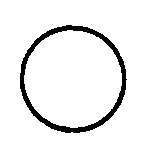
"Ntangu Ntangu, The Sun."
Vana vamonikana ntangu mbata. ina.
This sign signifies: " Even if I keep putting off talking the palaver with you, we will talk it out when the sun at midday is unclouded."

Ngonde Ngonde, The Moon.
Vana vantentimina ngonde katekuici.
The same meaning, but at midnight when the moon shines brightly.

Axe.
Xitali kukuanga nunkuanga kwinu.
When a man is about to die he says: "You may be killing me, but there is one who will avenge me."
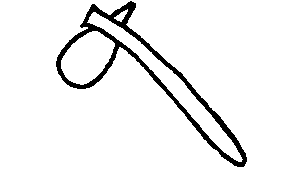
Hoe.
Nkuku sengo kufua nkuku li ambu (kufua) mpe. " The hoe may rust and vanish, but the word lasts for ever." This refers of course to their everlasting palavers, but it has the higher sense also.
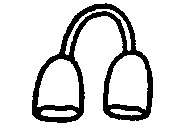 Ngonje.
Ngonje.
Beno nuzabici minu i li fumu'nci Budu lu ncikila ngonje. " Let all know that only on the death of a Prince, and by a Prince, can the ngonje be struck."
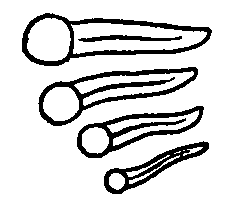
Bikula.
The four royal drums, representing the four fingers on the hand.
Bikula őuaci ku muntu ku fua bikula ku cikila mpe una ba cikila fumu ci.
"The drums that are heard by man only on the death of a great prince, and not at other times."

Ma Ku Ku.
The three lumps of ant-hill-earth, which women place under their pots to support them while their food is being cooked.
Ma Ku Ku ba tatu nzunga ku duku ka mpe.
"A pot on three stones does not upset."
When a woman comes with a matet [1] upon her head in which bottles of water are carried, she places them at her husband's feet, and if well educated, salutes him by clapping her hands three times, and says "makuku batu nzunga kuduku ka mpe."
One day an old lady visited me. She had taken nkasa, the poisonous bark, to prove to the world that it was not she who had caused death. She was wearing the red collar to show the people that she had taken nkasa and that successfully.
On one side of this red neck-scarf or collar, which is bound with white tape, were represented the moon, a native axe and a native hoe, and at the bottom the sun. This picture gives us the idea of the moon's place in creation, as the woman working with hoe and axe to supply man with food. On the other side were roughly represented the death-drum "Bikula," and a woman carrying a load upon her head, above the three makuku (or tops of small ant-hill) upon which the woman's cooking pot is placed. And where the two ends of the collar are joined together, a negro bell is attached.
Now when the BAVILI make a solemn oath (KU LEVA MPECI) they wet their finger
and make the sign of the Cross upon the earth and then touch their earth-covered
finger with their tongue.
General as this custom is even far inland, I have
always
[1. Long native basket made of palm leaves.]
looked upon it as one possibly introduced into the country by the early Portuguese.
Mr. Bentley translates the word cross EKULUZU, while Pčre Derouet gives the word KRUSSU, these are of course derived from the Portuguese word "Cruz."
Now in the capitals of all Kongo's once great provinces (now Kingdoms) four roads called NZILA NZAMBI or God's roads meet, and where they cross or rather separate they are called MAVAMBA, and these roads come from the East and West and North and South and represent the four great winds, MABILI the East from whence their religious ideas come, SENZA the strong West wind representing morality, XIKAMACI the North wind representing matter, reason and evil, and BUNZI the South wind representing the deep of the nervous system, the rain giver.
The signs by which the natives represent the Cross they call ZILA (or way),
and it is of the TAU form ![]() with the additions at the lower extremity of the inverted horns of the
Antelope
with the additions at the lower extremity of the inverted horns of the
Antelope  called MBAMBISA.
It is used on the collar of red saved list, worn by those who have taken the
powdered bark "NKASA," the ordeal to prove that they are not witches. It says
"We were of one . . . . stock and travelled by one way until this palaver parted
us."
called MBAMBISA.
It is used on the collar of red saved list, worn by those who have taken the
powdered bark "NKASA," the ordeal to prove that they are not witches. It says
"We were of one . . . . stock and travelled by one way until this palaver parted
us."
On Friday, January 5, 1900, Matueka came to see me, he informed me he had taken "casca." He was wearing the usual red collar round his neck and I asked him to explain the symbols worked in patchwork on it.
The sign near the top of the right shoulder, he said, we call nzila mavamba,
![]() , and it means that we were
born of one mother, and were one until strife divided us. The next sign, xala
mioko,
, and it means that we were
born of one mother, and were one until strife divided us. The next sign, xala
mioko,  is a seed that
opens and separates easily, and shows that I was open handed and generous. Then
the bellows, nsakaso,
is a seed that
opens and separates easily, and shows that I was open handed and generous. Then
the bellows, nsakaso,  points to the fact that it was my relations that caused me to treat
them as I have done. The nozzle to the bellows,
points to the fact that it was my relations that caused me to treat
them as I have done. The nozzle to the bellows,  , called nxelo, explains that
we were sons of one father, and that I, the son of one wife, had to contend
against my three half brothers, sons of another wife, The three ant-hills,
makuku matatu,
, called nxelo, explains that
we were sons of one father, and that I, the son of one wife, had to contend
against my three half brothers, sons of another wife, The three ant-hills,
makuku matatu,  , tell you
that I called witnesses, saluted them three times, and told them all about the
palaver. The mat, mbonda fulla
, tell you
that I called witnesses, saluted them three times, and told them all about the
palaver. The mat, mbonda fulla  , says that I put my accusers on one side just as they have placed me
on one side.;
, says that I put my accusers on one side just as they have placed me
on one side.;  , ntanji or
chair, points out that I was given a nice place in the town where I took casca,
and was well treated. Then Mbambisa,
, ntanji or
chair, points out that I was given a nice place in the town where I took casca,
and was well treated. Then Mbambisa,  the horns of an antelope, explains that I asked the question, "What
did I do to cause this dividing of the ways of the children of one father." And
the smaller drums "bikula,
the horns of an antelope, explains that I asked the question, "What
did I do to cause this dividing of the ways of the children of one father." And
the smaller drums "bikula,  , say, " Why was I forced to beat the Bikula and so let all the world
know that I was an outcast from my family?" Then when I had taken the bark and
proved my
, say, " Why was I forced to beat the Bikula and so let all the world
know that I was an outcast from my family?" Then when I had taken the bark and
proved my
innocence, I beat the drum ndungu ilo, as the sign 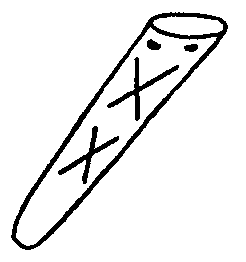 big drum, shows, to let the
world know that I was innocent. And I sent the ngonje,
big drum, shows, to let the
world know that I was innocent. And I sent the ngonje, 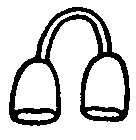 , or bell to my people to
announce the day of my return to town. And the Ximpaba,
, or bell to my people to
announce the day of my return to town. And the Ximpaba,  or knife of office was sent to
my accusers to demand damages.[1]
or knife of office was sent to
my accusers to demand damages.[1]
The Batexi, or Bateki, who say they are from the same Mother as the Bavili,
file their front teeth to two points, and mark each side of their face with
three marks ![]() .
.
The Bakuni file their front teeth to six points, and mark their face with six
strokes .
.
The Bavili file their front teeth to four points, and mark their stomachs thus:-
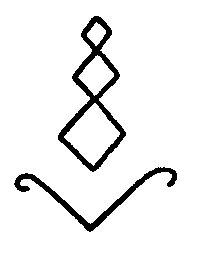
The Bakamba file their front teeth to six points, and have from one to three crocodiles tattooed on their stomachs.
The Bayaka and Basanji file their front teeth to two points, and have six keloids, in the form of lizards, on their stomachs.
In 188r, we in Landana heard of the wreck of the mail steamer Ethiopia off Luango, sixty or seventy miles away, one or two hours after its actual occurrence, in Luango, by drum message.
[1.These rough diagrams represent as nearly as possible the very rough patchwork figures on the red collar.]
This wonderful drum is called NKONKO, and is formed of a log of wood some six feet long. This log is then rounded; pieces at each end of what is destined to be the top side of the drum are left in the rough, to be carved and ornamented. From these pieces (nearly from end to end that is) a long thin slit or cut is made. This incision is about two inches deep and three finger-widths broad in the middle, narrowing at each end to two finger-widths. The rounding is then continued to the depth of the incision, then the drum is hollowed out by means of long chisels or gouges.
The drum being made, a good operator with his drumsticks can say anything he likes upon it in his dialect. The drum-language (so-called) is not limited to a few sentences but, given a good operator and a good listener, comprehends all a man can say.
I. The sound I (ee) is formed by operator striking the side of the drum
nearest to him, just in the centre of the drum, on the line of the
incision.
U is formed by hitting the belly of the drum on both sides at the
same time, when they say the sound comes out at either end of the incision.
A
is sounded by beating the line of incision to your left, near to that end of the
drum.
O, by beating the line of incision to the right of the I.
E, by
striking the line of incision on both sides of the drum between the letters A
and I.
The other letters are formed in combination with these vowel sounds by
striking the line with a second drum stick with more or less of emphasis or
precision.
The call to arms:-In yako-in yako-i zi fula i me yela.
Here (we are ready)-(get ready) there both powder and ball.
To call the men who are in the bush to town:-Beno boso nu duka.
You all (gather) together (in town) caution.
And when the native hears that an enemy is approaching, he advises him to come well prepared, or he will suffer:-Nu ba intu for bantu.[1]
You men.
In the early part of 1895 I sent the schooner Olhanensa from Luango to a place some sixty miles north, called Konkwatti, for the purpose of picking up some cargo there. One morning about ten o'clock my head man came to me, and after some hesitation told me that he had heard that the schooner was ashore. I could get nothing more definite out of him except that he had heard the "news." I knew enough about the rapidity with which bad news travels to believe that this misfortune must have occurred, and set about making the necessary preparations for despatching boats and implements to her rescue, so that the next day, when the messenger confirming the news arrived, all was ready and immediately forwarded. It appeared that the schooner had come ashore during the night previous to the arrival of the unofficial news, which probably had not been communicated to me until some time after it was the common property of the natives; that is to say, the news had travelled the sixty miles or so in three or four hours.
[1. This is particularly interesting, as giving the key to a perennial puzzle, revived during the Boer war, viz: How does news travel among the natives in the speedy way it does?]